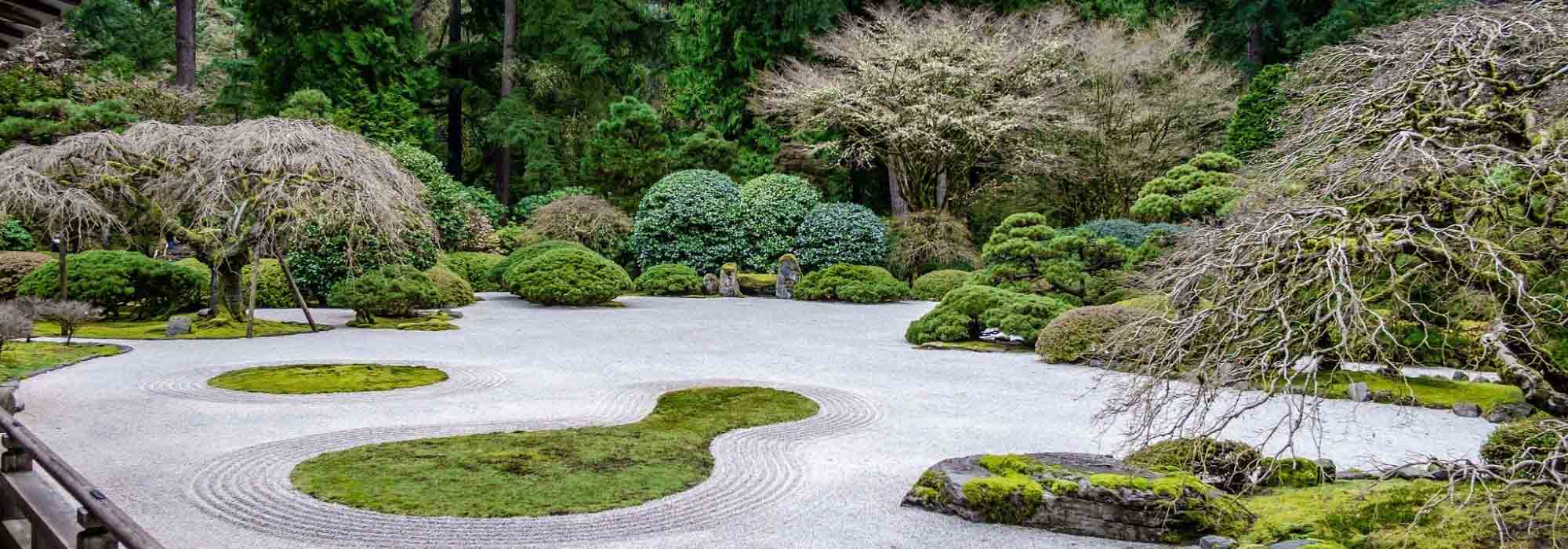
Mineral garden: 7 ideal bushes!
Best species and varieties for your gravel garden!
Summary
Mineral scree gardens on gravel are relatively easy to set up, but choosing plants can sometimes be tricky. If many perennials thrive in this type of layout, they don’t always provide strong structure, certainly not year-round. To achieve this, it is useful to turn to small bushes or trees, which will also tolerate growing among gravel or pebbles, while being easy to grow and requiring little care. They thus help to reinforce chosen atmosphere: Mediterranean-style garden, zen or Japanese garden, more naturalistic garden… In this article, I offer a selection of bushes perfectly suited to creating a scree garden. I could have mentioned the well-known classics such as olive and oleander, but I have chosen to present other genera, which also provide generous and distinctive flowering, enthralling scents, decorative foliage or remarkable fruiting.
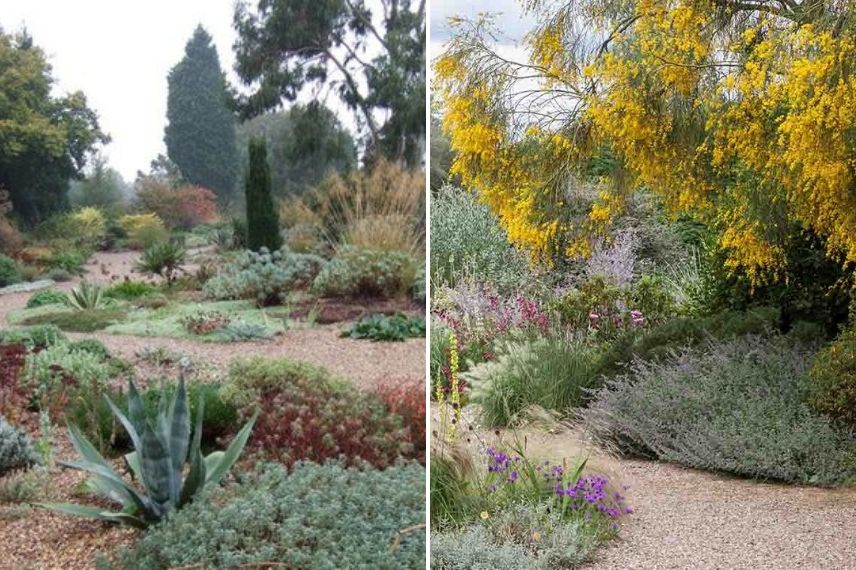
The spectacular and renowned Beth Chatto scree garden in England
Rockroses (Cistus)
Common in Mediterranean garrigue, rockrose is a champion for drought resistance and salt spray. Its evergreen, aromatic foliage is mostly green or greyish, covered with a fine down. In the Corbières rockrose it even takes purplish tints in cold, and variety ‘Rospico’ shows pale yellow margins. But rockrose is above all valued for its long flowering, between April and July, which is why it is so appreciated. Its wild-rose flowers are generally pure white (Sage-leaved rockrose, Montpellier rockrose), pale pink (Cistus ‘Peggy Sammons’) or darker (Cistus pulverulentus), set off by a centre of yellow stamens. In many varieties, such as the very popular Cistus purpureus, each petal is marked at its base with a deep crimson spot. Montpellier rockrose also adds fragrance to the beauty of its flowers. Rockroses do not exceed 1.50 m in height. Some form true groundcover with a spreading, prostrate habit (Cistus pulverulentus), others adopt a more regular, rounded habit (Ciste de crête, rockrose purple…). With rather slow growth, and not very long-lived, they tolerate fairly calcareous soil and require very well-drained soil. With average hardiness (-10°C), they are suited to regions with mild winters, although some can withstand occasional -15°C in good growing conditions. While they prefer full sun, varieties such as Cistus salviifolius grow without problem in shade, even dry shade, and among competing roots. Free from diseases, not requiring pruning, they make perfect candidates for your scree garden.
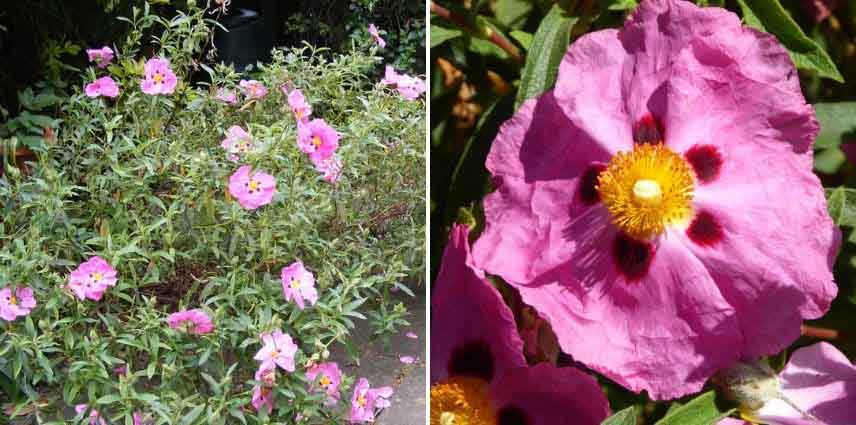
Rockroses are perfectly suited to a scree garden; here the magnificent Cistus purpureus with delicately crumpled leaves
Also discover two related genera: Halimiocistus ‘Merrist Wood Cream’, for its cream-white flowering, and Halimium commutatum, whose corollas display a bright pure yellow.
→ Select your preferred variety from our selection of rockroses.
→ Find out all about planting, cultivation and maintenance of rockroses in our dossier.
You may also read
How to create a gravel garden?Ceanothus (Ceanothus)
Ceanothus are bushes or small trees valued for their generous flowering and their diversity of sizes and habits. Some form prostrate groundcovers, reaching around 40 cm but spreading to nearly 2 m, such as Ceanothus prostratus. Others, by contrast, reach 3 m or more in stature, like varieties ‘Edinburgh’ or ‘Trewinthen Blue’. Flowering, in erect clusters of melliferous, more or less scented flowers, has earned them the nickname California lilac. Mostly blue (from darkest to palest), there are also forms with white or cream flowers (Ceanothus ‘Millerton Point’) or a delicate pale pink (Ceanothus ‘Marie Rose’). Flowers open either in spring (generally evergreen varieties such as ‘Puget Blue’) or in summer (deciduous varieties such as ‘Burkwoodii’). Some even produce several waves of flowering, which can continue into autumn (for example ‘Victoria’). Regarding foliage, green predominates (‘Concha’, ‘Gloire de Versailles’…), but some cultivars are available with variegated foliage (‘Cool Blue’, ‘Lemon and Lime’), in golden tones (‘African Queen’) or even in deep purple (‘Tuxedo’). Fairly fast-growing, Ceanothus are well suited to planting in mineral borders, in ordinary soil, even dry, and not too calcareous. Although lifespan usually does not exceed about twenty years, they have the advantage of resisting pollution, sea spray, and being relatively resistant to disease. They chiefly dislike waterlogged soils, and their hardiness, which varies, should guide your choice. Deciduous species withstand down to -15°C and can be planted in many regions. Evergreen ones cope less well with temperatures below -7°C and should be reserved for sheltered sites and gardens in mild climates.

Habit of a Ceanothus ‘Gloire de Versailles’ and inflorescence in a deep blue.
→ Discover all our Ceanothus varieties.
→ Everything about planting, care and pruning of Ceanothus in our guide.
Brooms (Cytisus and Genista)
Behind the name of Broom lie several botanical genera, such as Cytisus, Genista and Spartium. All are appreciated for their grace and remarkable flowering, which brighten gardens from spring to summer depending on genus used. From groundcover with a mat-forming habit not exceeding about twenty centimetres but covering up to 1 m of ground (Creeping broom), to large specimens several metres high (Pineapple broom, 4m x 3m), there is a wide range allowing them to be integrated into any planting scheme in a gravel garden. Their supple, evergreen shoots bear small deciduous green leaves, which are hidden beneath a mass of flowers in season. The corollas open singly or in clusters, either at stem tips or along the stems, and offer a wide palette of colours, each more luminous than the next. Bright yellow is widely represented (‘Golden Sunlight’, ‘Allgold’ or Lydia broom, to name just a few), but many other equally vibrant colours bring dynamism to a border. Deep pink-purple appears in the Purple broom, rich red in ‘Boskoop Ruby’, orange in the variety ‘Goldfinch’, multicoloured in the aptly named ‘Palette’, and even white if you choose the virginal Cytisus ‘Albus’. Flowering is often fragrant, a quality intensified in some varieties such as Spanish broom, with a notably bold character! With normal to rather slow growth and a relatively short lifespan (on average 5 to 10 years), they tolerate dry, poor soils and many accept limestone. Not prone to disease, they resist sea spray and temperatures around -15°C to -20°C, and while they thrive in full sun they can do well in part shade.

Scrubland effect for these cushions of broom (photo: B. Malfondet). On the right, golden-yellow butterfly-shaped flower.
→ In our online nursery, we offer a wide range of brooms.
→ In our article, discover how to plant, care for and prune broom.
You may also read
Rock garden: 12 suitable perennialsBottlebrushes (Callistemon)
Callistemon are bushes with an exotic look and distinctive flowering. Their varied sizes and silhouettes make them suitable for many uses. Some adopt a fairly low but broad habit (Callistemon salignus, 1.5 m x 4 m), while others eventually form upright specimens intended for the back of borders. Thus, Callistemon viminalis can reach 7 m in height with a 3 m spread. For small gardens, compact varieties such as ‘Mini Red’ (1.20 m x 80 cm) are ideal. In any case, their dazzling flowering cannot be missed, in more or less erect cylindrical spikes, which earned them the name ‘bottlebrush’. The flowers are borne at the tips of young shoots and come in bright shades, highlighted by prominent, equally colourful stamens. Often red (‘Captain Cook’ for example), the flowers can also be fuchsia pink (‘Hot Pink’), mauve (‘Mauve Mist’), white (‘Albus’) and there are even yellow varieties. First corollas may open from spring and recur throughout the season until late summer. Young foliage of bottlebrushes is often tinged with warm colours, later settling into various shades of green, with leaves more or less elongated, sometimes resembling needles. Evergreen, it is even aromatic in some species, such as Callistemon citrinus. Once the flowers have faded, curious spherical and decorative fruits appear, as if grafted to the bark. With rather rapid growth, Callistemon are decorative all year round. Planted in well-drained but cool soil, they tolerate drought. Resistant to wind and sea spray, their medium hardiness (-5°C to -8°C) makes them primarily suited to regions with mild winters, although some species, such as Callistemon rigidus, can withstand -12°C. Thriving in full sun in non-calcareous soil, they can tolerate a partly shaded position.
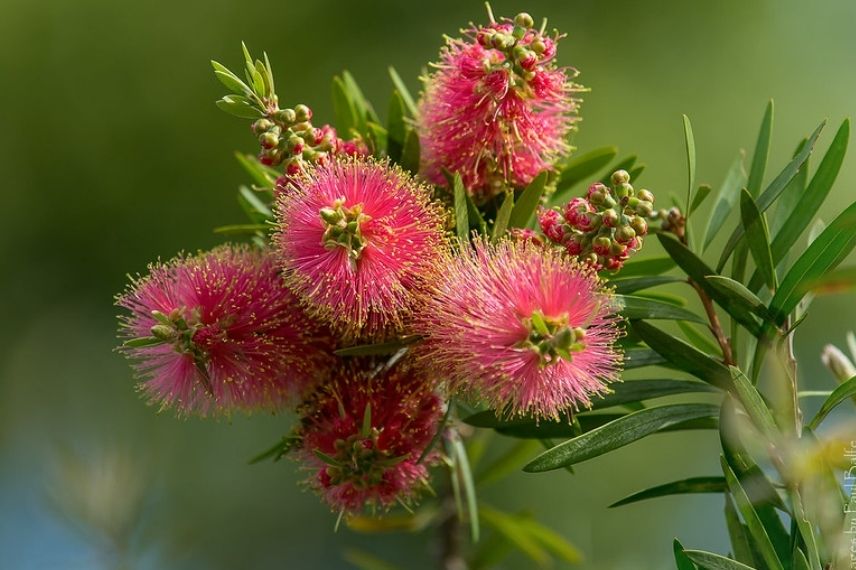
The striking and highly graphic flower of the bottlebrush (photo: P. Balfe)
→ Discover our selection of Callistemon.
→ All our advice for planting, maintaining and pruning Callistemon.
Sea buckthorns (Hippophae)
Known by various names (‘False buckthorn’, ‘thorny willow’, ‘sea alder’…), Sea buckthorn (Hippophae rhamnoides) is a tough customer! This bush 3 to 4 m across is indeed resistant to almost anything, or nearly so: cold (down to -30°C), drought, wind, sea spray, salt, pollution… nothing seems to affect it. This bush with a twisted habit produces numerous shoots covered with silvery hairs, as well as stout thorns, making it almost impenetrable. Its narrow, deciduous, silvery-grey foliage sometimes earns it the name ‘Siberian olive’. Although its spring flowering, which occurs on the naked wood, is relatively inconspicuous, it is followed by very numerous small round fruits, orange in colour, prized for their virtues. Edible, these berries are rich in various vitamins and can be eaten raw or cooked. If you or the birds do not pick them, they remain decorative all winter. To set fruit, female plants, such as Hippophae ‘Leikora’, need to be pollinated by a male plant, such as ‘Pollmix’. For self-fertile varieties, choose ‘Friesdorfer Orange’. With very rapid growth, sea buckthorn develops a suckering root system, making it ideal for stabilising soils. They tolerate all soil types, even sandy and calcareous soil, in full sun.
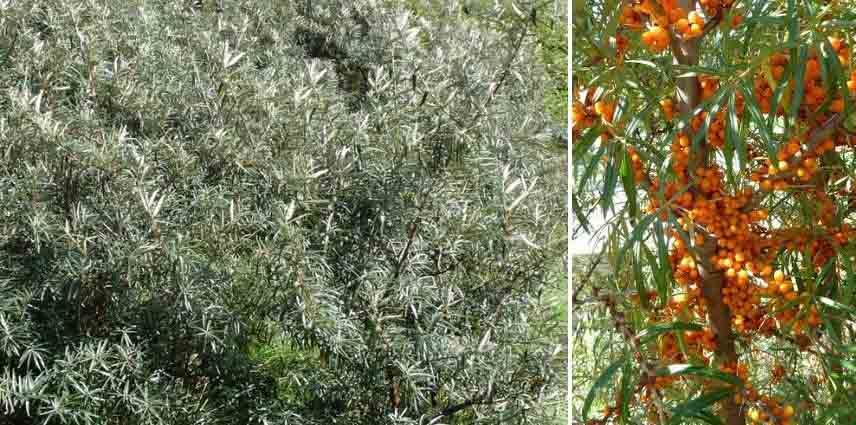
Sea buckthorn with fine grey foliage and its very decorative berries (photo W. Cutler)
→ Our different sea buckthorn varieties.
→ All about planting, cultivation and care of sea buckthorn in our guide.
Pomegranate trees (Punica)
Pomegranate bushes (Punica granatum) are known for their fleshy fruits, but there are also varieties cultivated for their generous and long flowering. Forming a sturdy bush, with a twisting habit, and of reasonable dimensions (3–5 m x 2–3 m), they bear young bronze foliage that turns green before colouring gold or orange in autumn. Many flowering pomegranate varieties are inermous and therefore bear no thorns. Bark, a pale beige, is especially admired in winter, when the bush, deciduous, has lost its leaves. Flowering is far more remarkable than on fruiting varieties, in corollas of about 6 cm, with crumpled petals. Often double or very double, they display warm hues, such as variety ‘Maxima Rubra’, with flowers of a striking vermilion red, or ‘Noshi Shibari’, red and orange. Punica ‘California Sunset’ in turn sports crumpled corollas blending orange, salmon and cream. Depending on region, flowering can start in April, but the most abundant period is in early summer. Note that these varieties never bear fruit. Slow-growing but very long-lived, pomegranate has limited hardiness (-12°C to -15°C) and needs a sheltered position in some regions. It is a bush that thrives in any well-drained soil, even calcareous, poor, stony or clayey.
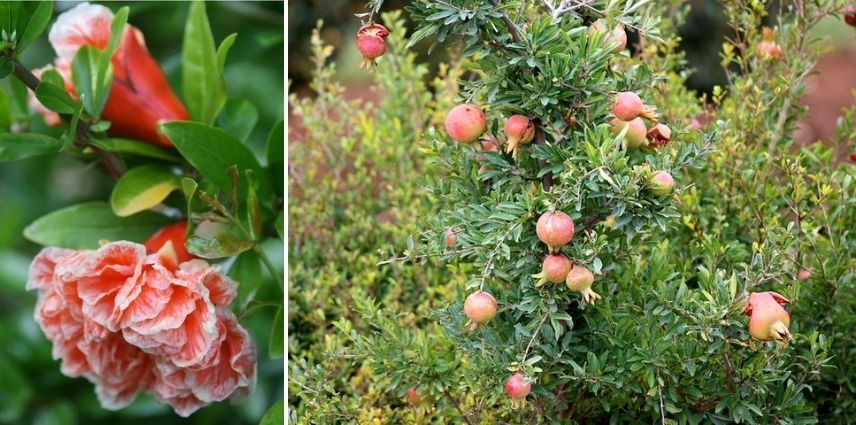
Left: variegated flower of cultivar ‘California sunset’ or ‘Mme Gravelle’; right: bush also very ornamental when bearing fruit (photo: A. Chapman)
→ In our nursery, we offer flowering and fruiting pomegranate bushes.
→ Learn how to plant, prune and maintain pomegranate bushes in our dedicated article.
Pines (Pinus)
Emblematic of both Mediterranean and Japanese gardens, Pines are conifers that bring a strong presence to the garden. While some grow very large, others remain more modest in size, making them suitable for planting in gravel compositions, even small ones. Their evergreen foliage can provide a permanent backdrop, and certain varieties add a real decorative value to your layout. Thus, Pinus ‘Fukai’ (2.5 m x 2 m) produces young blue-green shoots in spring and takes on golden tones in winter, as does Pinus ‘Winter Gold’ (2 m x 2.5 m), whose colours dazzle in low winter sun. If dark green and blue are well represented, you can create striking contrasts with paler colours, such as those offered by Pinus ‘Ophir’ (1 m x 1 m), with fresh light green tones. Decorative cones are also a selection factor, like the bluish, pendulous ones of Pinus ‘Negishi’ (2 m x 2 m). Habits and silhouettes vary greatly, from Pinus ‘Lilliput’ (1 m x 1.5 m), forming a regular, prostrate shrub, to Pinus ‘Green Tower’, whose regular leading shoot rises to 4 m, with a 1 m spread. Some cultivars adopt a twisting habit (Pinus ‘Bergman’, 90 cm x 1.2 m) or display a parasol silhouette (Pinus ‘Jane Kluis’, 50 cm x 1.5 m). Fond of full sun, Pines develop a shallow root system and show impressive longevity. Very adaptable, they tolerate different types of soil, full sun, drought, wind and cold (they are hardy to -15°C, or even lower).
→ Discover our wide range of Pines.
→ Planting, pruning and caring for pines, all advice in our article.
- Subscribe!
- Contents
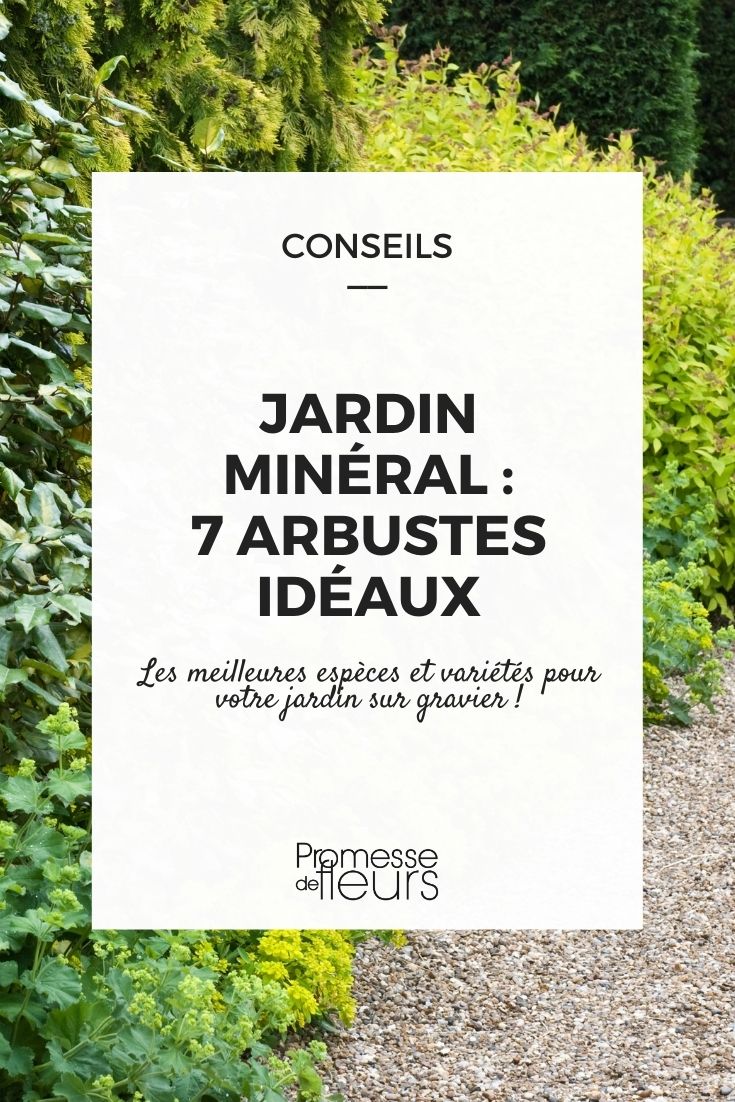































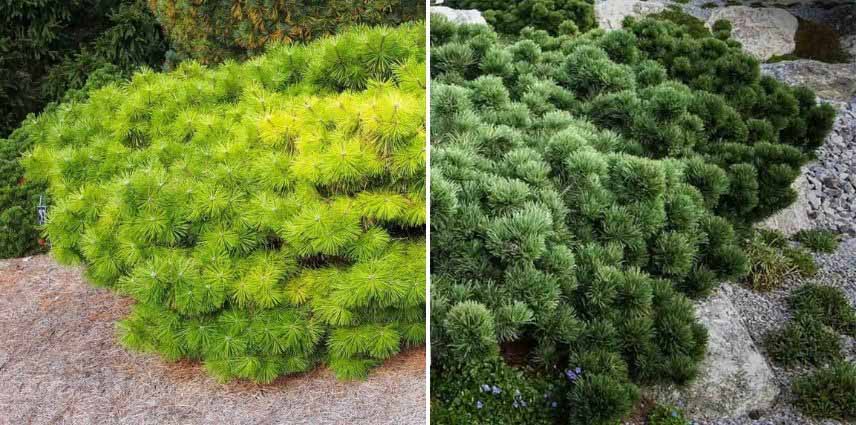
Feedbacks